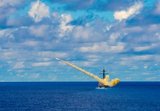USN orders spare parts for EO sensors
Sea Star Safire III thermal-imaging system on the USN aircraft carrier USS Dwight Eisenhower. (Photo: USN)
Teledyne FLIR is to provide the USN with spare parts for Sea Star Safire III, Brite Star II, Maritime 380HD and TacFLIR 380-HD EO sensor systems, the DoD announced on 26 October.
Work under a sole-source $43.94 million contract, awarded by the Naval Surface Warfare Center, is scheduled for completion by March 2027.
As the naval variant of the Star Safire system, Sea Star Safire III is being installed on USN Littoral Combat Ships. It has also been ordered by the Brazilian and Danish navies, Shephard Defence Insight notes.
Brite Star II is a variant of the Brite Star laser designation system. It includes a five-field of view (FOV), large-format thermal imager with a variable zoom setting; and a three-FOV, three-chip colour daylight camera.
TacFLIR 380-HD is an all-digital ISTAR sensor originally designed for land vehicle applications.
More from Digital Battlespace
-
![Babcock nears first customer for Nomad AI translation tool]()
Babcock nears first customer for Nomad AI translation tool
Nomad can provide militaries with real-time intelligence, saving critical time on the battlefield.
-
![AUSA 2025: Israel’s Asio Technologies to supply hundreds of improved Taurus tactical systems]()
AUSA 2025: Israel’s Asio Technologies to supply hundreds of improved Taurus tactical systems
Taurus operates alongside the Israel Defense Forces’ Orion system which supports mission management across tens of thousands of manoeuvring forces, from squad leaders to battalion commanders.
-
![AUSA 2025: Kopin pushes micro-LED plans as China moves faster]()
AUSA 2025: Kopin pushes micro-LED plans as China moves faster
The plan for the new displays follows fresh investment in Kopin’s European facilities by Theon and an order for head-up displays in fielded aircraft, with funding from the US Department of Defense.
-
![AUSA 2025: Persistent Systems to complete its largest order by year’s end]()
AUSA 2025: Persistent Systems to complete its largest order by year’s end
Persistent Systems received its largest ever single order for its MPU5 devices and other systems earlier this month and has already delivered the 50 units to the US Army’s 4th Infantry Division.
-
![Aselsan brings in dozens of companies and systems under the Steel Dome umbrella]()
Aselsan brings in dozens of companies and systems under the Steel Dome umbrella
Turkey has joined the family of countries attempting to establish a multilayered air defence system with government approval in August 2024 for the effort landed by Aselsan. Dubbed Steel Dome, the programme joins Israel’s Iron Dome, the US Golden Dome, India’s Mission Sudarshan Chakra and South Korea’s low-altitude missile defence system.
-
![DSEI 2025: MARSS unveils new agnostic multidomain C4 system]()
DSEI 2025: MARSS unveils new agnostic multidomain C4 system
MARSS’ NiDAR system has been deployed using sensors from static platforms to provide detection and protection for static sights, such as critical infrastructure, ports and military bases.




























